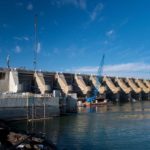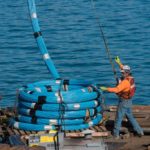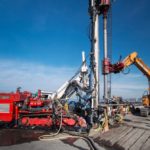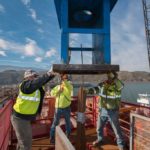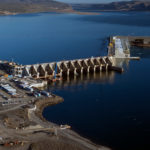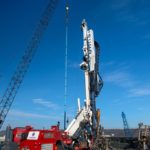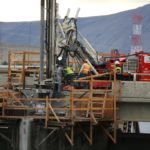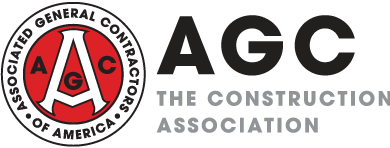- Company: Nicholson Construction Company
- Industry: Water/Wastewater
- Location: Beverly, Washington
- Expected Completion Date: June 1, 2015
- Project Website
In February of 2014, workers noticed a slight misalignment in the roadway deck curbs and handrails located at the top of the spillway during a routine maintenance inspection. Further investigation showed that the top of Pier 4 had moved more than two inches downstream. A follow-up dive inspection revealed a 65-foot long by two-inch wide crack that spanned the full length of Monolith 4. The owner of the dam, Grant County Public Utility District, immediately mandated a drawdown of the dam’s reservoir to relieve pressure on the spillway monoliths.
After extensive investigation, it was determined that the crack was caused by mathematical errors in the initial design calculations and late changes to the final spillway design. It is also suspected that there may have been problems curing the concrete the weekend it was poured due to unusually hot temperatures.
Post-tension anchors were selected as the repair solution for Monolith 4, along with drilling lift joint drains above the gallery to reduce uplift pressure resulting from cracking within the body of the dam. The restraining force necessary to stabilize the dam required thirty-five 61-strand tendon anchors with lengths up to 260 feet installed through the dam structure. The cracks in Monoliths 2 and 4 were repaired to reduce seepage, decrease water pressure, and improve stability. The grouting program included patching and sealing followed by an intricate sequence of cement grout injections.
The District developed a two-part strategy to restore the reservoir elevation as soon as possible. An intermediate pool raise occurred after repair of the cracked monolith and some preventative measures were installed. The reservoir was restored to the maximum pool level after completion of all remedial measures in March 2015.
What impact does this project have on America?
Upon assessing the potential for dam failure, the District immediately lowered the upper pool level 26 feet; which had the effect of cutting hydroelectric power generation by approximately half for the central region of Washington. In addition to the reduction in hydro-electric power generation, there were also impacts to the local communities and the tourism industry surrounding Wanapum Lake. The lake serves as a popular destination for recreational activities like boating, swimming, fishing, camping, and hiking. It also serves as a critical passage for salmon migrating upstream.
Directly downstream about 20 miles from Wanapum Dam is its sister dam, Priest Rapids Dam. Close to Priest Rapids Dam is Hanford Nuclear Reservation. This reservation is home to one of the United States’ largest volumes of radioactive waste, commercial nuclear power production, and scientific research facilities.
Wanapum Lake upstream of the dam and the areas directly downstream of the dam were immediately closed upon lowering the pool level; boat ramps and inlets were left completely dry, campsites were closed, and boating activity was banned on the lake. Law enforcement increased patrols during the summer to protect Native American archaeological sites now exposed by the receding shoreline. Headlines in the newspapers and television news coverage kept most of the state of Washington informed about the drawdown and schedule for completion for an entire year as the impact effected many people in a variety of ways.
What interesting obstacles or unusual circumstances did you overcome to complete the project?
The Public Utility Districts invested several million dollars ($3 million at Wanapum Dam alone) on fish ladders to allow the native spring Chinook salmon reach their upstream spawning ground destination while the waters of the Wanapum Reservoir were lowered.
What dangers and risks did you encounter, and describe any extraordinary methods used to keep workers safe?
The most grueling challenge on the project was the drilling to advance 16-inch boreholes necessary to install the 61-strand tendons, which required careful planning and precision through highly variable and highly fractured basalt rock. In this case, the fractured basalt rock could take more than a half dozen attempts of grouting and re-drilling to achieve water tightness.
An additional sixty-nine solid bar anchors, a majority of which were 3-inch diameter, were installed under water through the ogee spillway. The entire drilling, grouting and anchor tensioning processes were performed with the assistance of divers and using remote cameras to allow engineers at the surface to witness the underwater operations.
How did you leverage new technologies to work faster and reduce waste?
The collaborative working relationship between the District, MWH, Nicholson and Kuney Goebel JV resulted in a very successful project at Wanapum Dam. The consistent team approach harbored creative solutions to overcome unique challenges in design, planning, and construction phases of the project. It is also with this collaboration that the team was able to meet the schedule-demanding milestones to successfully rehabilitate Wanapum Dam with quality and safety at the forefront.
